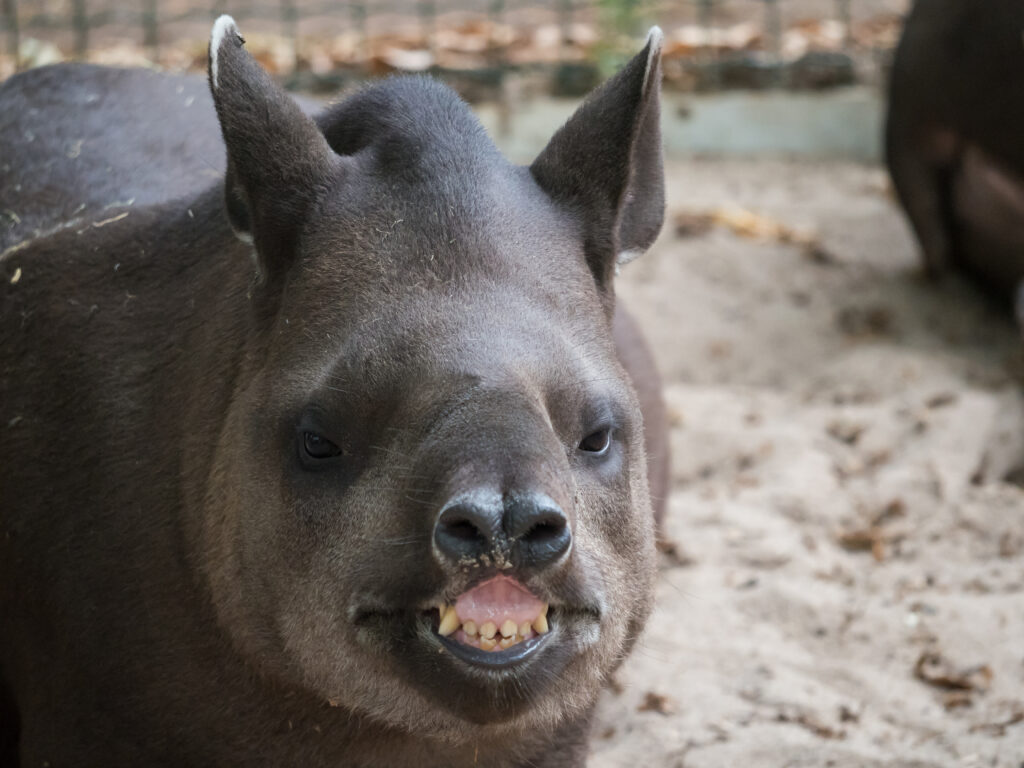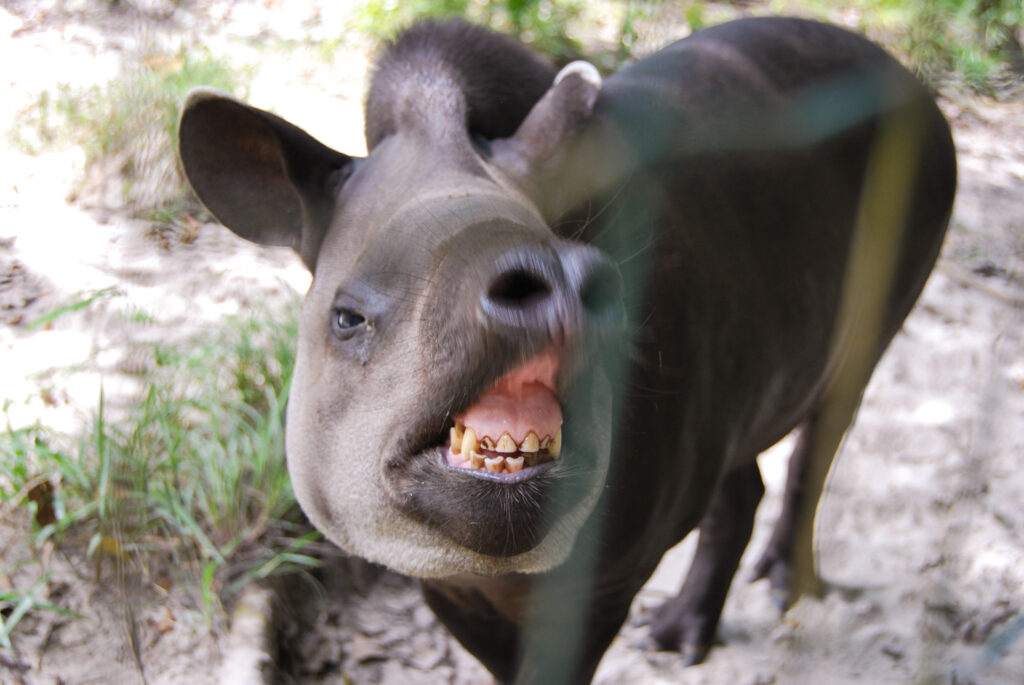Tapirs are fascinating and unique animals. These large, herbivorous mammals are known for their distinctive body shape. Their barrel-like torso, short legs, and long, flexible proboscis make them a memorable sight. With four extant species found in Central and South America and Southeast Asia, tapirs have a long evolutionary history dating back millions of years and have adapted to a wide range of habitats and environmental conditions. Tapirs possess a secret weapon in their mouths – their teeth. Their unique dentitions hold the key to understanding the evolutionary adaptations of these curious herbivores. Keep reading to discover more about tapir teeth!

Their barrel-like torso, short legs, and long, flexible
proboscis
make tapirs a memorable sight.
©Janusz Pienkowski/Shutterstock.com
What kind of Teeth Do Tapirs Have?
Tapirs are herbivores, which means they feed on plant material. Their diet consists of leaves, fruits, twigs, and other vegetation. Tapirs have a unique digestive system that allows them to efficiently extract nutrients from tough, fibrous plant material. They have a large cecum. The cecum is a specialized chamber in the digestive tract. It houses beneficial bacteria and enzymes that help break down cellulose and also other plant fibers. While tapirs are primarily herbivores, they have been known to occasionally consume small amounts of insects, crustaceans, and other small invertebrates. However, these are generally not a significant part of their diet and are consumed by tapirs as a source of additional protein or minerals.
Tapir Milk Teeth
Like most mammals, tapirs have milk teeth, also known as deciduous teeth or baby teeth. These teeth are not fully developed at birth. They will continue to grow and develop over the first few weeks of life. Initially, the deciduous teeth are small and hidden beneath the gums. As the calf nurses and starts to eat vegetation, the teeth will begin to emerge from the gums. They continue to grow until they are fully formed. It can take several months for the deciduous teeth to reach their full size and shape. They will eventually fall out and are replaced by permanent teeth. The timing of the replacement of deciduous teeth varies depending on the species, but it usually occurs within the first two years of life.

Tapir incisors are separated by gaps called
diastemata
,
©Chrissi4788/Shutterstock.com
Tapir Adult Teeth
The timing of the development and eruption of permanent teeth in tapirs can vary based on the species. In general, tapirs will have a full set of permanent teeth by the time they are two to three years of age. The process of tooth replacement begins with the shedding of the deciduous teeth and also the eruption of the permanent teeth. The permanent teeth continue to grow and develop until they reach their full size and shape, which can take several months to a few years. As with other mammals, when their permanent teeth decay and/or fall out, that’s all she wrote. There are no replacements or implants.

Despite their simpler structure, tapir premolars are highly effective at breaking down plant material.
©88studio/Shutterstock.com
How Many Teeth Do Tapirs Have?
Tapirs have a total of 44 teeth, with the following apportionment across their different types:
- Incisors: Tapirs have a total of 3 incisors on each side of their upper and lower jaws, for a total of 12 incisors.
- Canines: Tapirs have one pair of long, curved canines in their upper and lower jaws for a total of 4 canines.
- Premolars: Tapirs have 4 premolars on each side of their upper and lower jaws, for a total of 16 premolars.
- Molars: Tapirs have 3 molars on each side of their upper and lower jaws, for a total of 12 molars.
Incisors
Tapirs have a total of 12 incisors, which are located in the front of their mouth. They have six upper incisors and six lower incisors. Their incisors are separated by gaps called diastemata, (singularly diastema) which allow tapirs to grasp and manipulate food while feeding. These specialized gaps are one of the adaptations that have allowed tapirs to successfully adapt to their herbivorous diet.
Canines
Tapirs have two long, well-developed canines in their upper and lower jaws, which are used in foraging, and when necessary for defense. The canines help position and grasp plant matter.
Premolars
A tapir’s premolars are specialized teeth that are located between the canines and molars in their jaws. They are used for chewing and grinding tough plant material, such as leaves and stems. Tapirs have a total of 16 premolars, with four located on each side of their upper and lower jaws. These premolars are different from molars in that their cusps (raised points on the chewing surface) are less complex. Despite their simpler structure, tapir premolars are still highly effective at breaking down plant material.
Molars
Tapirs have molars 12 with complex ridges and cusps that are specialized for grinding tough plant materials. These molars have evolved to have sharp edges and cusps that allow them to effectively break down plant fibers.
How Do Tapirs Use Their Teeth?
Tapirs use their teeth for a variety of purposes, including biting and cutting vegetation, grinding and crushing tough plant material, and defending themselves from predators. Their incisors are used to nip and clip foliage, while their canines are used for grasping and for defense against potential threats. The premolars and molars are used for grinding and chewing plant material. They have specialized ridges and cusps that help them break down tough fibrous vegetation. Tapirs’ teeth are adapted to their herbivorous diet, allowing them to efficiently extract nutrients from the plants they eat, and to defend themselves when necessary. However, tapirs are peaceful animals that tend to avoid conflict and aggression whenever possible.

Tapirs use their teeth for a variety of purposes, including biting and cutting vegetation, grinding and crushing tough plant material, and defending themselves from predators.
©Margus Vilbas Photography/Shutterstock.com
Tipar Bite Force
Tapirs are relatively large creatures. They weigh from 300 to 700 pounds (150- 300 kg). Tapirs have strong jaws and powerful muscles that allow them to bite through tough vegetation and plant material. It is estimated that a tapir’s bite force can range from 200 to 400 pounds of pressure, depending on the size and species of the tapir. This is relatively strong for herbivorous animals and is an adaptation that allows them to efficiently process their tough, fibrous diet. However, it is important to note that tapirs are not aggressive animals and will typically only use their bite as a form of defense if they feel threatened or cornered.
The photo featured at the top of this post is © Margus Vilbas Photography/Shutterstock.com
FAQs (Frequently Asked Questions)
What are tapir and where do they live?
Tapirs are fascinating and unique animals. These large, herbivorous mammals are known for their distinctive body shape. Their barrel-like torso, short legs, and long, flexible proboscis make them a memorable sight. With four extant species found in Central and South America and Southeast Asia
What is a cecum?
The cecum is a specialized chamber in the tapir’s digestive tract. It houses beneficial bacteria and enzymes that help break down cellulose and other plant fibers.
How many teeth do tapirs have?
Tapirs have a total of 44 teeth, with the following apportionment across their different types:
- Incisors: Tapirs have a total of 3 incisors on each side of their upper and lower jaws, for a total of 12 incisors.
- Canines: Tapirs have one pair of long, curved canines in their upper and lower jaws for a total of 4 canines.
- Premolars: Tapirs have 4 premolars on each side of their upper and lower jaws, for a total of 16 premolars.
- Molars: Tapirs have 3 molars on each side of their upper and lower jaws, for a total of 12 molars.
How do tapirs use their teeth?
Tapirs use their teeth for a variety of purposes, including biting and cutting vegetation, grinding and crushing tough plant material, and defending themselves from predators. Their incisors are used to nip and clip foliage, while their canines are used for grasping and for defense against potential threats. The premolars and molars are used for grinding and chewing plant material. They have specialized ridges and cusps that help them break down tough fibrous vegetation.
How strong is a tapir's bite force?
It is estimated that a tapir’s bite force can range from 200 to 400 pounds of pressure, depending on the size and species of the tapir. This is relatively strong for herbivorous animals and is an adaptation that allows them to efficiently process their tough, fibrous diet. However, it is important to note that tapirs are not aggressive animals and will typically only use their bite as a form of defense if they feel threatened or cornered.
Thank you for reading! Have some feedback for us? Contact the AZ Animals editorial team.






